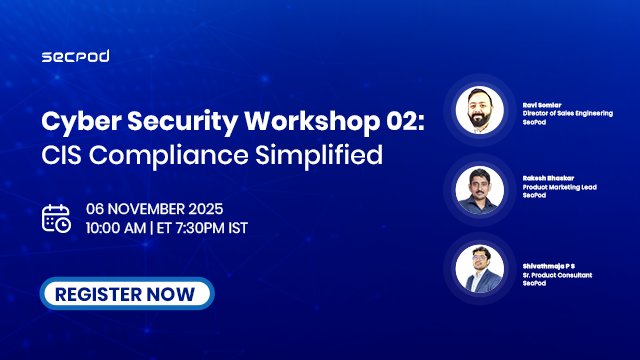Cloud Workload Protection Platform (CWPP)
Cloud Workload Protection Platform (CWPP)
CWPPs are integral for organizations that enjoy the benefits of cloud environments in today’s highly sophisticated threat landscape. These platforms help address the security requirements of workloads, providing organizations with the ability to handle vulnerabilities, maintain compliance, and manage their security posture effectively.
Before jumping into what constitutes a cloud workload protection platform and how it benefits businesses, let’s first understand what it is.
What is a Cloud Workload Protection Platform?
Cloud workload protection platforms are designed to safeguard workloads across multiple cloud environments, including public, private, and hybrid setups. They focus on security measures tailored to the unique requirements of workloads, including runtime protection, behavioral anomaly detection, and granular access controls rather than relying solely on perimeter defenses. They also deliver security coverage tailored to modern distributed architectures by addressing risks directly within workloads.
Core Features of the Ideal CWPP
Listed below are some of the main capabilities of an effective cloud workload protection platform.
Vulnerability Management
Vulnerability management serves as a core component of cloud workload protection platforms. They provide continuous scanning and assessment of workloads to detect vulnerabilities, prioritizing them based on severity and exploitability. Automated patching capabilities further streamline remediation efforts, reducing exposure windows.
A CWPP’s vulnerability management features typically include:
- Automated vulnerability scans
- Threat prioritization based on contextual analysis
- Integration with ticketing systems for remediation tracking
- Patch management and virtual patching options
Posture Management
Posture management evaluates and improves the security configurations of cloud workloads. Moreover, misconfigurations often present entry points for attackers, which makes proactive monitoring a necessity. As a result, cloud workload protection platforms continuously monitor infrastructure configurations against security best practices and industry standards.
workload protection platform’s posture management features typically include:
- Configuration drift detection
- Continuous compliance assessments
- Policy enforcement frameworks
- Alerting for misconfigured resources
Posture management tools can also integrate with Infrastructure as Code (IaC) frameworks, enabling security assessments during development phases.
Compliance Management
Compliance management addresses regulatory requirements and industry standards, ensuring organizations meet legal obligations related to data security. Cloud workload protection platforms facilitate audits by automating compliance checks and generating reports aligned with frameworks, such as GDPR, HIPAA, and PCI DSS.
workload protection platform’s compliance management features typically include:
- Pre-configured compliance templates
- Real-time compliance monitoring
- Audit logs and evidence collection
- Automated remediation suggestions for non-compliance issues
Benefits of CWPP
Here’s a quick glance at the benefits of cloud workload protection tools.
- Comprehensive visibility: They consolidate insights across workloads, which in turn provide unified dashboards for monitoring vulnerabilities, configurations, and compliance.
- Scalability: Organizations can scale security measures in alignment with workload growth without adding significant operational complexity.
- Automation: From vulnerability scanning to compliance checks, automation reduces manual effort and response times.
- Flexibility across environments: Whether workloads operate in public clouds, private data centers, or hybrid environments, workload protection platforms offer consistent security controls.
Integrating CWPP with DevSecOps
Modern development pipelines increasingly emphasize security integration from the outset. Consequently, cloud workload protection platforms play a crucial role in supporting DevSecOps initiatives by embedding security checks within CI/CD workflows. As a result, developers can address vulnerabilities and misconfigurations early, thereby reducing the risk of deploying insecure code.
Selecting the Right Workload Protection Platform
When evaluating cloud workload protection platforms, organizations should consider the following factors:
- Compatibility: To begin with, ensure compatibility with multicloud and hybrid environments.
- Ease of integration: Next, assess how well the platform integrates with existing tools and workflows.
- Reporting capabilities: Additionally, look for platforms that provide actionable insights through detailed reports.
- Customization options: Finally, determine whether security policies can be tailored to meet specific organizational needs.
FAQs About Cloud Workload Protection Platforms
What types of workloads do CWPPs support?
They typically support virtual machines (VM), containers, and serverless functions across cloud environments.
Can CWPPs detect zero-day vulnerabilities?
While they focus on known vulnerabilities, some platforms incorporate behavioral analysis and anomaly detection to identify potential zero-day threats.
How do CWPPs integrate with cloud service providers?
In most cases, they offer APIs and native integrations with major cloud providers, which, in turn, enable seamless deployment and management.
Are CWPPs suitable for small businesses?
Yes, in fact, many of them provide scalable pricing models, thereby making them accessible to smaller organizations.
What role do CWPPs play in incident response?
They contribute by providing threat intelligence, forensic data, and automated remediation tools during incident handling.
How do CWPPs differ from endpoint protection platforms?
Unlike endpoint protection, they are workload-focused, and designed for cloud environments rather than traditional devices.
What compliance standards do CWPPs address?
They often support standards like GDPR, HIPAA, PCI DSS, and ISO 27001, among others.
How often should vulnerability scans be performed?
Best practices recommend continuous or scheduled scans, depending on workload changes and risk assessments.

